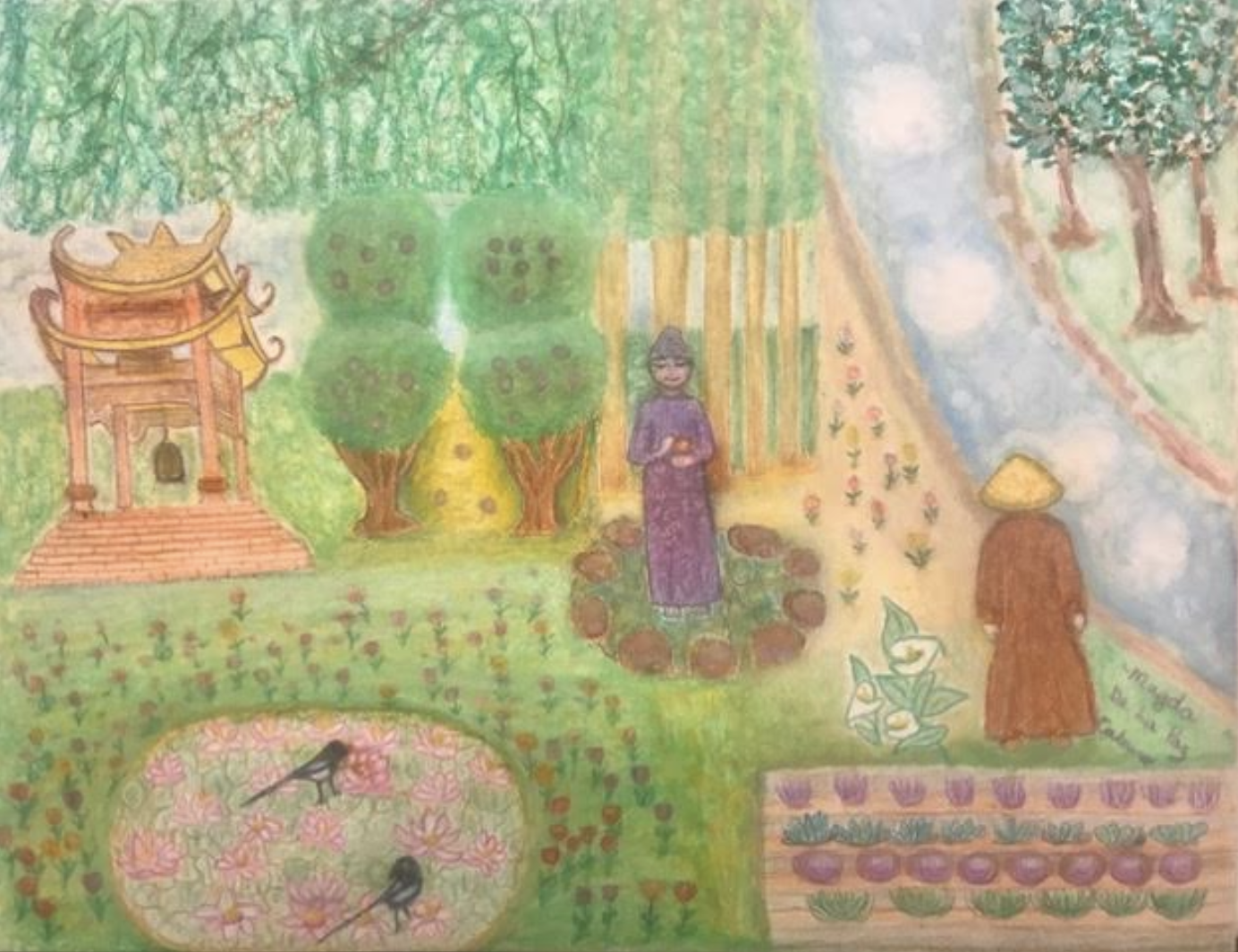artwork by Magda Cabrero
Need Zoom tech support? Email Phyllis here.
(support available before sangha starts)
Dear friends,
We invite you to join us this Monday, June 13, at 7pm EDT.
Magda will facilitate at our online sangha.
Magda shares:
PLUM VILLAGE, BODHISATTVA OF THE SPRING
On my way to Plum Village, I stay at a hotel in Bordeaux. My room is sparsely furnished and decorated; instead there hang on the walls a few drawings of ordinary objects. This makes me think of Becoming Animal, where David Abrams writes about how most humans tend to conceptualize and represent nature instead of perceiving and experiencing it. I ponder the relationship between we humans and nature, reflecting on how many of us barely speak or think about nature with reverence, or cultivate our possibilities for interbeing. We often forget that verbal communication is just one form of expression among many, and that other organisms detect in us nonverbal manifestations such as our chemical emanations and waves of energy.
Many human cultures teach their children to view nature as something to objectify, own, and master; a stock of resources waiting to be utilized. Children are rarely provided with vital information for the health of our planet, or taught to appreciate that “no one is too small to make a difference,” as suggested in the title of Greta Thunberg’s book. Thich Nhat Hanh tells us that the earth is not just a space we occupy.
We humans have evolved in consanguinity with the earth. We need to honor and cultivate our coexistence with it. It is vital to give back to the earth in the measure that we take from it. We are embedded in the world: we are in, with and of the earth. We need to take stock of the wealth of nonverbal expressions that surround us, and express reverence and appreciation when we speak about the earth.
BODHISATTVA
With these ideas in mind, I spend my first spring visit at Plum Village’s Lower Hamlet with the intention of being in full awareness of all its natural manifestations. I aim to be mindful not just of what I am accustomed to perceiving through my senses, but of deeper and more subtle realities.
Upon arriving, I find that spring is in full and exuberant bloom at Plum Village. Tall grasses color-washed in multiple wild flower-pigments, the farm, banana trees, domestic varieties such as lilies, roses and velvet plants, circular bamboo groves, the plum orchard, the poplar forest and all kinds of other flora. Plum Village’s natural surroundings fit Thich Nhat Hanh’s description of Mother Earth as a Bodhisattva. Most residents are engaged in some kind of earth project. The monks and nuns are building a bench with bamboo branches. I know that Thay would have felt fully satisfied with this microcosmos. We all are his continuation, humans and nature.
As I walk through the farm, I say to myself: At Plum Village the phrase “We are what we eat” truly resonates. I read a sign: “Happy farmers make the world a better place”. I know that much of the abundance of vegetables that we eat at Plum Village grows here. Whenever we eat at Plum Village, our food and those who make it possible are never taken for granted. One bowl of food contains the cosmos. I would like to return next spring to help the happy farmers, spending a lot of time with my hands in the soil.
As I walk by the plum orchard, I notice how many people walk barefoot and how spontaneously our feet relax their pace. I believe that most of us are mindful that the terrain underfoot is a living presence. Intuitively we remember the ancestral replenishing affinity between our bodies and the earth, our more-than-gravitational bond.
UNDER THE WILLOW TREE
I sit under the weeping willow tree in front of the lotus pond. From my bench I see the pagoda, Thay’s house, the eating hall, the back of the library, and the plum orchard by the poplar tree forest. I see all kinds of organic matter in the mud underneath the pond’s surface, like the whole cosmos plays a part in feeding the lotus flowers.
I am mesmerized by the elegant black and white eurasian magpie taking a bath in the pond. When it opens its wings the black becomes a translucent blue and green. Does this bird live here the whole year or does it migrate? How many times has it flown to Plum Village? If I were a bird, I would choose Plum Village too.
While I delight in the magpie, I suddenly feel the wind caressing and tickling my skin, brushing against and tangling my hair. My thoughts now turn to the air: Earth is also here, in the transparent medium that enfolds us.
I hear the wind whispering in my ear, and the poplar leaves jostling and swaying, touching each other. Like the clapping of happy castanets, harmonious in their own choral disorder.
I can smell the mossy poplar scent transported by the wind and soon become aware of my own breathing. I breathe in and ponder the fluid exchange between all Plum Village’s emanations and mine. I breathe out and know that the whole breath of the cosmos is present in my breathing. We – Plum Village and I - breathe in unison. Traces of the environment that surrounds me - the spring scents and pollens, particles, spider webs, earth, sky and water elements, the fermenting compost, insect pheromones, and more - is inhaled, metamorphosed and exhaled. Breathing in and out, I am in, with and of the earth.
POPLAR CATHEDRAL
In Plum Village I find myself walking through the poplar forest several times a day. I love to look at the heart-shaped leaves reflecting the sun in all directions, in different shades of green, gold and silver. Most of the trees’ trunks are covered by moss and ivy, in different shades of beige, brown, black and green. I think about the immeasurable abundance of organic life that each tree sustains, what I can and cannot perceive. I cannot see a single tree that appears to be dying.
During walking meditation, the sister asks us to stop and face the trees. I can’t resist the impulse to touch the bark of the nearest tree or to bring my nose close to smell it. Like the boy in A Christmas Story, I want to taste it but think that touching and smelling the tree is already odd enough, even by Plum Village standards.
Depending on where I stand, the rows of trees look straight or perpendicular. They are playing all kinds of protean optical illusion games with me. I imagine myself as a child playing hide-and-seek. Do they run to take a different spot every time I am not looking? I can take a winding path through this improvised labyrinth, a path that brings me closer to home.
I ponder the connections among all the poplar trees. My imagination runs free. Do they feel my presence, my energy of enchantment? Are they as drawn to me as I am to them? I feel a totemic connection with these trees.
THAY’S CREEK
“... as a closed book on a shelf continues to whisper to itself its own inexhaustible tale.”
— Annie Dillard
Another place I visit several times a day is Thay’s favorite sitting spot, in front of the creek. In the morning, the creek is covered with cotton-like fiber, like clouds in an overcast sky. The trees’ seeds form cotton sails so they can travel far in the spring wind. How clever is that? When I return in the afternoon I am surprised at how the cotton-clouds have shifted towards the lower part of the creek. Like my Puerto Rican sky, overcast on one side and clear on the other.
This creek, whose rich organic depth is another representation of the cosmos, inspires vivid thoughts about Thich Nhat Hanh’s deep impact on my life. I especially remember his messages of impermanence and continuation. The creek both flows and endures, always reinventing itself. Thay will always be a part of this creek, all the rich organic matter below and above the surface, and all its surroundings, including myself.
KINSHIP WITH THE EARTH
At Plum Village what I never understood becomes clear and simple. I remember my pure, simple ways.
In unison with the earth’s rhythms, these words sprout while I sit in front of the Black Buddha in the depths of the poplar cathedral.
At Plum Village in the spring I regain an ancestral innocence that brings me back to my deepest kinship with the earth.
For dharma sharing you might consider the following questions:
1) Describe a place where you feel a deep connection with nature.
2) Describe an experience in nature that has heightened your sense of wellbeing and creativity.
3) Describe a meditation exercise that you have engaged in while in connection with nature.
4) Share your thoughts and/or feelings about your relationship with nature.
5) Share anything you would like to say to celebrate and demonstrate your appreciation for Mother Earth.

